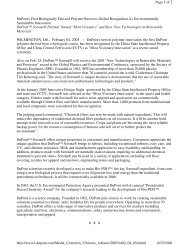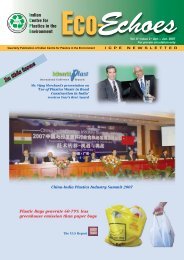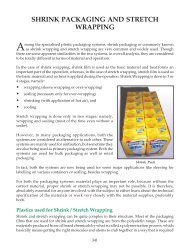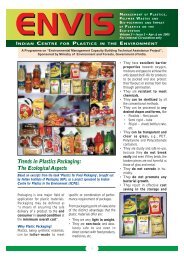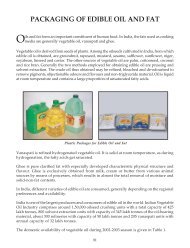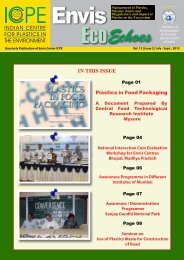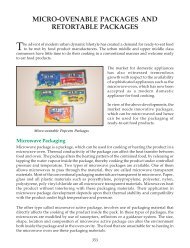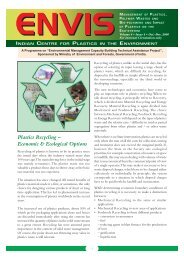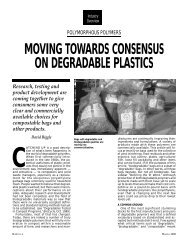packaging of ready-to-eat/ready-to- cook food - Indian Centre for ...
packaging of ready-to-eat/ready-to- cook food - Indian Centre for ...
packaging of ready-to-eat/ready-to- cook food - Indian Centre for ...
Create successful ePaper yourself
Turn your PDF publications into a flip-book with our unique Google optimized e-Paper software.
PACKAGING OF READY-TO-EAT/READY-TO-<br />
COOK FOOD<br />
Convenience <strong>food</strong> is a concept that is prevalent in the developed world since long, while its<br />
inception in<strong>to</strong> the <strong>Indian</strong> market has been recent. With the changing socio-economic pattern<br />
<strong>of</strong> life and the increasing number <strong>of</strong> working couples, the concept is fast becoming popular in<br />
<strong>Indian</strong> market. This type <strong>of</strong> <strong>food</strong> is becoming popular because it saves time and labour. This<br />
<strong>food</strong> has extended shelf-life and is available <strong>of</strong>f the market shelves.<br />
Extruded Ready-<strong>to</strong>-Cook Products Packed in<br />
Plastic Pouches<br />
Packaged/convenience <strong>food</strong> products sec<strong>to</strong>r has been slow in penetrating the large potential<br />
presented by <strong>Indian</strong> 250 million strong middle class. But due <strong>to</strong> growing urbanisation and<br />
changing <strong>food</strong> habits, the demand has been rising at a good pace and there is enough latent<br />
market potential waiting <strong>to</strong> be exploited through developmental ef<strong>for</strong>ts.<br />
The convenience <strong>food</strong> could be basically classified in<strong>to</strong> two categories:<br />
• Shelf – stable convenience <strong>food</strong><br />
• Frozen convenience <strong>food</strong><br />
Shelf-stable convenience <strong>food</strong> are further classified as:<br />
• Ready-<strong>to</strong>-Eat (RTE) and Ready-To-Serve (RTS) <strong>food</strong> - e.g. Idlis, dosas, pav bhaji, m<strong>eat</strong><br />
products like pre-<strong>cook</strong>ed sausages, ham, chicken products, curries, chapattis, rice,<br />
vegetables like aloo chole, navratan kurma, channa masala etc.<br />
• Ready-<strong>to</strong>-Cook <strong>food</strong> – e.g. instant mixes like cake mixes, gulab-jamun mix, falooda mix, icecream<br />
mix, jelly mix, pudding mix etc., pasta products like noodles, macaroni, vermicelli etc.<br />
Packaging Requirements <strong>of</strong> Ready-<strong>to</strong>-Eat (RTE) and Ready-<strong>to</strong>-Serve<br />
(RTS) Food<br />
A “<strong>ready</strong>-<strong>to</strong>-<strong>eat</strong>” <strong>food</strong> product may be defined as any <strong>food</strong> product which does not require any<br />
elaborate processing procedures on the part <strong>of</strong> consumer be<strong>for</strong>e it is good enough <strong>for</strong><br />
151<br />
Ready-<strong>to</strong>-Cook/Ready-<strong>to</strong>-Eat Food in<br />
Plastic Pouches
consumption. It is <strong>ready</strong>-<strong>to</strong>-<strong>eat</strong> as soon as the pack is opened in a <strong>for</strong>m, which is tasty and<br />
appetizing.<br />
The advancements in <strong>food</strong> technology and <strong>packaging</strong> technology have made it possible <strong>to</strong><br />
extend the shelf-life <strong>of</strong> these products. Be<strong>for</strong>e deciding which <strong>packaging</strong> material is <strong>to</strong> be<br />
used, it is necessary <strong>to</strong> know the <strong>packaging</strong> requirements <strong>of</strong> the product i.e. what hazards<br />
will cause product deterioration and the conditions <strong>to</strong> which the packaged<br />
product will be subjected throughout its shelf-life. Some important <strong>packaging</strong><br />
considerations, which influence the selection criteria <strong>for</strong> choosing <strong>packaging</strong> materials,<br />
are highlighted.<br />
• Product Characteristics<br />
• The type <strong>of</strong> <strong>food</strong> and its composition, moisture, fat, protein, flavour etc.<br />
• Form and shape <strong>of</strong> the product – smooth, regular, irregular, with sharp edges etc.<br />
• Nature <strong>of</strong> the product – crisp, brittle, sticky etc.<br />
• Fac<strong>to</strong>rs Affecting Packaging<br />
Fac<strong>to</strong>rs responsible <strong>for</strong> the spoilage <strong>of</strong> the <strong>food</strong> products:<br />
• Biological spoilage due <strong>to</strong> micro-organisms<br />
• Abiotic spoilage due <strong>to</strong> chemical reactions like oxidation, hydrolysis and enzymatic<br />
reactions.<br />
• The environmental fac<strong>to</strong>rs like light, humidity and temperature.<br />
• The <strong>food</strong> processing parameters eg. processing temperature and duration.<br />
• The shelf-life desired <strong>for</strong> a given <strong>ready</strong>-<strong>to</strong>-<strong>eat</strong> <strong>food</strong>, influences the type <strong>of</strong> <strong>packaging</strong> and<br />
processing parameters <strong>to</strong> be used.<br />
Ready-<strong>to</strong>-<strong>eat</strong> snacks like idlis, dosas, pav bhaji etc. are sold across the counter and have a very<br />
short shelf-life, hence the <strong>packaging</strong> requirements <strong>of</strong> these products are different from those<br />
<strong>of</strong> <strong>ready</strong> <strong>to</strong> <strong>eat</strong> products like curry rice, upma, vegetable biryani etc., which are re<strong>to</strong>rt processed<br />
<strong>for</strong> longer shelf-life.<br />
Products like idlis, dosas, pizzas are packed<br />
in <strong>packaging</strong> materials having low water<br />
vapour and oxygen permeability, odour and<br />
grease resistance, and good physical<br />
strength. The <strong>packaging</strong> materials generally<br />
used are injection moulded plastic<br />
containers, plastic film/bag pouches or<br />
paperboard car<strong>to</strong>ns.<br />
In normal practice, the <strong>ready</strong>-<strong>to</strong>-<strong>eat</strong> <strong>food</strong> are<br />
consumed in a short span <strong>of</strong> time, but with the<br />
advancement in <strong>packaging</strong> technology, it is<br />
now possible <strong>to</strong> produce these items<br />
commercially and <strong>to</strong> extend the shelf-life up<br />
<strong>to</strong> a few years.<br />
152<br />
Ready-<strong>to</strong>-Eat Products Packed in Re<strong>to</strong>rt Packs
TABLE 1<br />
Use <strong>of</strong> Various Packaging Laminates/Composites<br />
Material Properties Use<br />
9 mm foil / adhesive / Good moisture barrier, Over wraps confectioneries<br />
paper coated with h<strong>eat</strong> runs well on machine<br />
sealing vinyl resin<br />
9 mm foil / adhesive / paper / Good moisture barrier, Fin-sealed pouches and<br />
polyethylene (extruded) runs well on machine sachets – soups, etc.<br />
1 in. polyethylene / 9 mm foil / H<strong>eat</strong> seals by the wax Over wraps <strong>for</strong><br />
adhesive / paper bleeding through the tissue confectionery<br />
9 mm foil / adhesive / paper / Low WVTR Over wraps <strong>for</strong> biscuits, etc.<br />
micro-wax comp. /<br />
tissue (20 g/m 2 )<br />
Foil Excellent WVTR, good Candy wrap, biscuit wrap<br />
machinability<br />
Cellophane / wad / cellophane Excellent WVTR, sandwich Bags or pouches <strong>for</strong><br />
printing, good machine hygroscopic items<br />
per<strong>for</strong>mance<br />
Cellophane / adhesive / Excellent gas barrier, Nut packing with inert gas<br />
pli<strong>of</strong>ilm transparent pack<br />
Cellophane/polyethylene Excellent gas barrier, trapped Chocolate, etc.<br />
printing<br />
Polyester film / Saran coated High strength, positive sealing Vacuum <strong>food</strong> Pouches<br />
polyethylene<br />
Polyester / adhesive / foil / Excellent gas barrier, good Flexible processable cans<br />
polyethylene h<strong>eat</strong> resistance, good rigidity,<br />
aroma retention<br />
153
<strong>Indian</strong> <strong>food</strong> like palak paneer, dal fry, curry rice, upma, vegetables biryani etc. are re<strong>to</strong>rt<br />
processed hence their <strong>packaging</strong> requirements are different. These products are re<strong>to</strong>rt<br />
processed because they are low acid <strong>food</strong> with moderate <strong>to</strong> large size particles; hence it<br />
is easy <strong>to</strong> remove oxygen from the head-space by gas flushing. The selection <strong>of</strong> a polymer<br />
or its combination is based on the requirement <strong>of</strong> barrier properties.<br />
Re<strong>to</strong>rt pouch is a special package in which the perishable <strong>food</strong> items are preserved by<br />
physical, and/or chemical means. It is a flexible laminate, which can withstand<br />
thermal processing, and combines the advantages <strong>of</strong> the metal can and the boil-inbag.<br />
Ready-<strong>to</strong>-use re<strong>to</strong>rt pouches are flexible packages made from multilayer plastic films<br />
with or without aluminium foil as one <strong>of</strong> the layers. Unlike the usual flexible packages,<br />
they are made <strong>of</strong> h<strong>eat</strong> resistant plastics, thus making them suitable <strong>for</strong> processing in<br />
re<strong>to</strong>rt at a temperature <strong>of</strong> around 121°C. These re<strong>to</strong>rt pouches posses <strong>to</strong>ughness and<br />
puncture resistance normally required <strong>for</strong> any flexible <strong>packaging</strong>. It can also withstand<br />
the rigours <strong>of</strong> handling and distribution. The material is h<strong>eat</strong> sealable and has good<br />
barrier properties.<br />
In India, 3-ply laminate consisting <strong>of</strong> PET/Al Foil/PP is commonly used <strong>for</strong> <strong>packaging</strong> <strong>of</strong><br />
<strong>ready</strong> <strong>to</strong> <strong>eat</strong> re<strong>to</strong>rt packed <strong>food</strong>. The product packed in such laminates has a shelf-life <strong>of</strong><br />
one year. The other materials generally used in re<strong>to</strong>rt pouch structure includes nylon,<br />
silica coated nylon, ethylene vinyl alcohol (EVOH) and polyvinyledene chloride (PVDC).<br />
These materials have high moisture barrier properties and are used successfully <strong>for</strong><br />
<strong>packaging</strong> <strong>of</strong> <strong>ready</strong>-<strong>to</strong>-<strong>eat</strong> high moisture <strong>Indian</strong> <strong>food</strong>. Table 1 gives typical materials used<br />
<strong>for</strong> <strong>packaging</strong> <strong>of</strong> various <strong>food</strong>.<br />
Both pre<strong>for</strong>med pouches as well as pouches<br />
<strong>for</strong>med on FFS machines are used. Pre<strong>for</strong>med<br />
pouches are <strong>of</strong> flat and stand - up type. The<br />
typical structure <strong>of</strong> these pouches are:<br />
Flat configuration : 12µ PET/12µ Al foil/<br />
75µ PP<br />
Stand up configuration : 12µ PET/9µ Al foil/<br />
15µ OPA/60µ PP<br />
The pouches are printed in attractive colours.<br />
The re<strong>to</strong>rt pouch is a space saving package by<br />
value <strong>of</strong> its design. It is a good substitute <strong>for</strong><br />
tinplate cans as it eliminates the need <strong>for</strong> the<br />
addition <strong>of</strong> brine in the <strong>food</strong>.<br />
In conclusion, the market <strong>for</strong> re<strong>to</strong>rt pouches<br />
is certainly one that will continue <strong>to</strong><br />
experience growth over the next few years, as<br />
the re<strong>to</strong>rt pouch gets acceptable as equal <strong>to</strong> or<br />
even superior <strong>to</strong> glass or metal containers. The<br />
pouch has the same shelf-life as the can or the<br />
154<br />
Ready-<strong>to</strong>-Cook Products Packed in Flexible<br />
Plastic Pouches
jar. The re<strong>to</strong>rt pouch needs <strong>to</strong> address ease <strong>of</strong> opening and re-closing (compared <strong>to</strong> glass<br />
jars). In addition, the <strong>packaging</strong> economics <strong>of</strong> the pack <strong>for</strong> mass volume products will depend<br />
upon the ability <strong>to</strong> increase filling speeds and <strong>to</strong> move from batch <strong>to</strong> continuous re<strong>to</strong>rt<br />
processing.<br />
Also, the re<strong>to</strong>rt pouch can save about 60% energy while processing. Furthermore, as the product<br />
is al<strong>ready</strong> sterile, it does not require additional low temperature s<strong>to</strong>rage.<br />
Packaging Requirements <strong>of</strong> Ready-<strong>to</strong>-Cook (RTC) Food<br />
Based on their initial moisture content, RTC <strong>food</strong> can be broadly classified as:<br />
Low Moisture Food<br />
• Moisture 1 <strong>to</strong> 5%<br />
• Equilibrium Relative Humidity<br />
(ERH) 18-20%<br />
These <strong>food</strong> have very low moisture and<br />
ERH. Hence they have the tendency <strong>to</strong><br />
absorb moisture from the surroundings<br />
and turn soggy, thereby, loosing their<br />
crisp, brittle nature and taste. The most<br />
important fac<strong>to</strong>r <strong>to</strong> be considered, is<br />
moisture vapour transmission rate<br />
(MVTR) <strong>of</strong> the <strong>packaging</strong> materials<br />
used. MVTR values <strong>of</strong> less than 1 gm /<br />
m 2 / 24 hours are required.<br />
Medium Moisture Food<br />
• Moisture 6 <strong>to</strong> 20%<br />
• ERH up <strong>to</strong> 65%<br />
• Typical examples: <strong>Indian</strong> savory snacks, sweetm<strong>eat</strong>s<br />
Barrier property (MVTR) requirement <strong>for</strong> these <strong>food</strong> is less stringent, however, <strong>for</strong> longer<br />
shelf-life, microbiological spoilage has <strong>to</strong> be given due importance. Use <strong>of</strong> preservatives is<br />
<strong>of</strong>ten required.<br />
High Moisture Food<br />
• Moisture 20 <strong>to</strong> 60%<br />
• ERH up <strong>to</strong> 85%<br />
• Typical examples:<br />
Freshly baked products<br />
– bread, cake, chapatti,<br />
pickles, chutneys,<br />
sauces etc.<br />
155<br />
Vermiclli in Plastic Pouches<br />
Plastic Pouches <strong>for</strong> Ready-<strong>to</strong>-Cook Food
For freshly baked products such as bread, cake, ERH is <strong>of</strong>ten higher than the ambient ERH.<br />
There<strong>for</strong>e the products tend <strong>to</strong> br<strong>eat</strong>he out the moisture and if excess water vapour is not allowed<br />
<strong>to</strong> escape from the closed package, condensation on the outer surface <strong>of</strong> the product occurs,<br />
spoiling the product quality and leading <strong>to</strong> mould / yeast growth. Plastic films such as low<br />
density polyethylene (LDPE), which are permeable <strong>to</strong> water vapour are normally used <strong>for</strong><br />
<strong>packaging</strong> these products <strong>for</strong> shorter shelf-life.<br />
For longer shelf-life, microbial spoilage is the main consideration. The products are sterilized<br />
and packed in hermetically sealed containers such as cans, re<strong>to</strong>rt pouches or aseptic packs.<br />
Medium and high moisture <strong>food</strong> are very susceptible <strong>to</strong> the microbial spoilage and need adequate<br />
processing and preservation methods, prior <strong>to</strong> their <strong>packaging</strong>.<br />
Oxygen /Air Permeability<br />
RTC <strong>food</strong> normally contain fat as well as other ingredients that can be oxidised. If oxygen/<br />
air is allowed <strong>to</strong> come in contact with the packaged <strong>food</strong>, oxidative degradation <strong>of</strong> fat<br />
occurs, and many other oxidative changes take place, which cause rancidity, <strong>of</strong>f flavour<br />
and discolouration in the <strong>food</strong>. Hence, <strong>packaging</strong> material <strong>for</strong> high fat should have low<br />
oxygen permeability.<br />
Nitrogen Permeability<br />
To protect the <strong>food</strong> from oxygen/moisture, the <strong>food</strong> is usually packed in an inert atmosphere<br />
<strong>of</strong> Nitrogen ( N 2 ). The N 2 permeability <strong>of</strong> the package should be low <strong>to</strong> prevent its escape in<strong>to</strong><br />
the atmosphere.<br />
Grease Resistance Properties<br />
A variety <strong>of</strong> RTC <strong>food</strong> have edible oil and fat as their ingredients. Fat/oil during s<strong>to</strong>rage<br />
should not adversely affect the <strong>packaging</strong> material used <strong>for</strong> these products, as fat may ooze<br />
out.<br />
HDPE and LDPE are affected by fat and are not suitable <strong>for</strong> packing fatty products. Polyester<br />
films, cellophane, polypropylene, inomer films etc. are suitable <strong>for</strong> such applications. If made<br />
in laminates, then the film <strong>of</strong>fering excellent grease resistance is used as the innermost liner <strong>of</strong><br />
the laminate.<br />
Flavour and essential oils contribute <strong>to</strong> the organoleptic qualities <strong>of</strong> many RTC <strong>food</strong>. They are<br />
volatile substances and hence gas permeability <strong>of</strong> the <strong>packaging</strong> material should be very low<br />
<strong>to</strong> prevent flavour loss. This is also necessary <strong>to</strong> block the entry <strong>of</strong> the outside oxygen and air,<br />
which could bring out the oxidative changes in flavour.<br />
Light Sensitivity<br />
Light accelerates oxidative changes associated with the flavours and fats in <strong>food</strong>. Opaque<br />
<strong>packaging</strong> materials such as cans and aluminium foil <strong>of</strong>fer best protection from light.<br />
Metallised polyester and pigmented plastics are found quite satisfac<strong>to</strong>ry. Light could cause<br />
discolouration in coloured <strong>food</strong>. Some films are opaque <strong>to</strong> visible light but allow U.V. light<br />
<strong>to</strong> penetrate.<br />
156
Based on their major ingredients the <strong>ready</strong> <strong>to</strong> <strong>cook</strong> mixes can be divided in<strong>to</strong> four groups:<br />
• Cereal based<br />
• Legumes based<br />
• Fat rich, and<br />
• Spice enriched mixes<br />
The first category consisting <strong>of</strong> mixes <strong>for</strong> idli, dosa, chakli are mainly sensitive <strong>to</strong> moisture pick<br />
up only and require protection against this. These generally have moisture content in the region<br />
<strong>of</strong> 8 <strong>to</strong> 10% and become s<strong>of</strong>t and unacceptable at about 12 <strong>to</strong> 13% moisture content. Polyolefin<br />
plastic pouches <strong>of</strong> 37 <strong>to</strong> 75µ thickness are generally used <strong>for</strong> <strong>packaging</strong>, which provides 3-4<br />
months shelf-life.<br />
Legume or pulses based mixes comprise vada, khara sev, bonda, urad bath etc. have <strong>packaging</strong><br />
requirements similar <strong>to</strong> those <strong>of</strong> cereal based mixes, but have lower permissible moisture pickup.<br />
Hence, this requires <strong>packaging</strong> material having good water vapour impermeability. LDPE and PP<br />
pouches have been found <strong>to</strong> <strong>of</strong>fer 1½ <strong>to</strong> 3 months s<strong>to</strong>rage life under high temperature/RH<br />
conditions, which would correspond <strong>to</strong> 5 <strong>to</strong> 6 months under normal conditions.<br />
Ready mixes <strong>of</strong> Jamun, cake, doughnut etc., which have high fat content and milk solids are<br />
susceptible <strong>to</strong> rancidity and interactions with oxygen and water vapour. CPP pouches <strong>of</strong> 200<br />
grams capacity have been found <strong>to</strong> give short shelf-life <strong>of</strong> 2-3 months, which is adequate<br />
<strong>for</strong> local marketing. However, <strong>for</strong> longer shelf-life and export purposes, plain printed polyester<br />
with LDPE or HD-LDPE co-extruded films would be better suited from the point <strong>of</strong> protection<br />
and attractive appearance.<br />
Spice enriched mixes such as those <strong>of</strong> rasam, sambar, soup, bisibele bath are highly susceptible<br />
<strong>to</strong> aroma loss, oxidative deterioration changes and seepage <strong>of</strong> oil. Unsupported PE or PP<br />
pouches are inadequate <strong>to</strong> pack these items. More functional ones based on cellophane/PE,<br />
plain or metallised PET/PE, and co-extruded films with polyamide core layer provide longer<br />
shelf-life.<br />
Food mixes such as orange peel gravy, tamarind sauce etc. have very low moisture pickup<br />
<strong>to</strong>lerance and necessitate the use <strong>of</strong> highly fat resistant and flavour resistant packages.<br />
Innermost layer <strong>of</strong> HD-LDPE coextruded film, ethylene-acrylic acid copolymer provide<br />
the required properties and good h<strong>eat</strong> sealability.<br />
Frozen Convenience Food<br />
The current trend in frozen <strong>food</strong> is dual ovenability i.e. products that can be h<strong>eat</strong>ed in a<br />
microwave oven or a conventional oven. Shelf – stable re<strong>to</strong>rtable <strong>food</strong> are better suited <strong>for</strong><br />
microwave h<strong>eat</strong>ing. Aluminium trays which represented 85% <strong>of</strong> the market in the eighties are<br />
being replaced by other materials like paperboard, thermoset plastics and thermoplastics owing<br />
<strong>to</strong> the growing importance <strong>of</strong> microwave ovens. Among the three materials, paperboard has a<br />
image as well as functional problem. Consumers perceieve it as a low quality material. Also, it<br />
s<strong>of</strong>tens in the presence <strong>of</strong> moisture and chars under high temperature conditions. Thermoset<br />
plastics also have several disadvantages. It is expensive and heavy, which increases shipping<br />
costs. It is brittle, stains easily and processes slowly. There<strong>for</strong>e, processors are looking <strong>to</strong> other<br />
materials like thermoplastics. Three critical properties <strong>to</strong> be considered when selecting<br />
157
thermoplastics <strong>for</strong> dual-ovenable packages are dimensional stability up <strong>to</strong> 200°C <strong>to</strong> 250°C, good<br />
impact strength at freezer temperatures <strong>to</strong> reduce shipping and s<strong>to</strong>rage damage and<br />
microwaveability. Other important properties include compliance with FDA regulations,<br />
absence <strong>of</strong> taste and odour, good release characteristics so that the <strong>food</strong> does not stick. This<br />
property is very important <strong>for</strong> baked <strong>food</strong>. The different types <strong>of</strong> dual ovenable packages are<br />
explained here.<br />
Ovenable Plastic Based Food Trays<br />
These trays are manufactured by therm<strong>of</strong>orming sheets <strong>of</strong> polypropylene (PP), high impact<br />
polystyrene (HIPS) and crystalline polyethylene terephthalate (CPET), each material <strong>of</strong>fering<br />
specific advantages in per<strong>for</strong>mance and economics. The trays are vacuum <strong>for</strong>med or<br />
therm<strong>of</strong>ormed from a reel <strong>of</strong> sheet.<br />
When extended shelf-life is required, PP is co-extruded with barrier resins such as EVOH <strong>to</strong><br />
improve barrier properties <strong>for</strong> <strong>for</strong>ming. PP trays cannot withstand conventional oven<br />
temperatures and are used only <strong>for</strong> microwave ovens. Foamed polystyrene trays with special<br />
blends <strong>of</strong> low density polystyrene can withstand much higher temperatures, however, they<br />
are used generally only <strong>for</strong> microwave with an advantage <strong>of</strong> good cost saving as compared <strong>to</strong><br />
the CPET trays. CPET trays have distinct advantage <strong>of</strong> dual ovenability. They also very<br />
remarkably withstand the abuse <strong>of</strong> retail distribution. Their other advantages include design<br />
flexibility, resistance <strong>to</strong> oil and grease and no appreciable effect on <strong>food</strong> taste. CPET trays are<br />
stable from – 40°C <strong>to</strong> as high as 200°C and exhibit improved oxygen and water vapour<br />
barrier.<br />
All plastic trays are <strong>to</strong>pped with h<strong>eat</strong>-sealable lidding films or snap-on plastic domes.<br />
Ovenable Board<br />
Earlier developments were based on paperboard coated with TPX. This was expensive and<br />
the preferred material now is solid bleached sulphate board, extrusion coated with polyethylene<br />
terephthalate (PET). This material is resistant <strong>to</strong> exposure in hot-air ovens and <strong>to</strong> temperatures<br />
<strong>of</strong> 200-250°C. It is also used <strong>for</strong> containers <strong>for</strong> <strong>food</strong> <strong>to</strong> be re-h<strong>eat</strong>ed in microwave ovens<br />
only.<br />
The coated board is made in<strong>to</strong> containers by two main methods. One technique produces<br />
containers by press <strong>for</strong>ming <strong>to</strong> give trays or dishes similar <strong>to</strong> the conventionally pressed foil<br />
trays. An alternative system is based on existing car<strong>to</strong>n technology and erects trays from flat<br />
car<strong>to</strong>n blanks. The main reasons <strong>for</strong> the current interest in ovenable board trays are:<br />
• Growing popularity <strong>of</strong> convenience <strong>food</strong><br />
• Developments <strong>of</strong> the microwave oven<br />
• Developments <strong>of</strong> polyester coated ovenable board that is suitable <strong>for</strong> use in both microwave<br />
and conventional hot - air ovens<br />
Ovenable board containers have <strong>to</strong> satisfy a number <strong>of</strong> per<strong>for</strong>mance requirements. First and<br />
<strong>for</strong>emost, the material must be permeable <strong>to</strong> microwave radiation. Metal surface reflects<br />
microwave radiation so that the aluminium foil dishes are not really suitable <strong>for</strong> microwave<br />
oven use. Containers intended <strong>for</strong> general use must also be h<strong>eat</strong> resistant at temperatures up<br />
158
<strong>to</strong> 200-250°C, which will normally be encountered in hot air ovens. Resistance <strong>to</strong> h<strong>eat</strong> includes<br />
a requirement that there should be no thermal degradation, browning or odour development.<br />
The material in contact with the <strong>food</strong> must be chemically inert and have <strong>food</strong> contact approval.<br />
It should also be grease resistant.<br />
The coating should be h<strong>eat</strong> sealable and the material as a whole should be easily convertible at<br />
high speeds. Because the filled containers will normally be s<strong>to</strong>red under deep-freeze conditions,<br />
the ovenable board must have good deep-freeze per<strong>for</strong>mance. Good printability is also a<br />
requirement.<br />
Production <strong>of</strong> PET-coated board is carried out by extrusion coating. Pre-tr<strong>eat</strong>ment <strong>of</strong> the board<br />
is necessary <strong>to</strong> give good adhesion <strong>of</strong> the coating. The behaviour <strong>of</strong> the <strong>to</strong>tal coated structure<br />
<strong>of</strong> both flame and corona board is limited by the cohesion <strong>of</strong> the clay coating.<br />
References<br />
1. Guide on Food Products, Vol II by Laad, V. D.<br />
2. Modern Food Packaging<br />
3. Packaging India, Vol 35, No. 5, Dec–Jan ’03, Plastic Films <strong>for</strong> Processed Food – Special<br />
Requirements by Rashmi Motey, Smita Lele<br />
4. Packaging India, Vol 33, No 5, Dec 2000 – Jan ’01, Specialized Packaging <strong>for</strong> Food Products by<br />
A. S. Athalye<br />
5. Handbook <strong>of</strong> Packaging – Plastics by A. S. Athalye<br />
159



